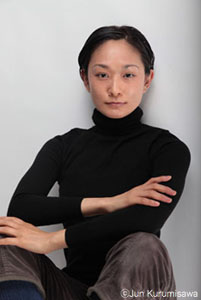
Akiko Kimura was born in 1970 in Tokyo. Learned ballet dance and street dance in her youth, she studied dance theory at Waseda University and began to build a professional career as a choreographer in show business while still in her teens. She choreographed many pieces for commercial films, fashion shows and plays. In 1994, she founded her own company Leni-Basso. In 1995-1996, she stayed in Germany for a year as a resident artist sent by the Agency for Cultural Affairs of Japan and observed the situation of contemporary dance in Europe. In 2001, she was invited to Bates Dance Festival to create two short pieces: a group piece in collaboration with the dancers participating in the festival and her solo work Face-Mix by which she attracted great attention and won recognition in the U.S. She created one of her master pieces Finks and performed more than 60 times in many countries.In 2003, she was invited to ADF (American Dance Festival) to create a short piece titled Enact Oneself with ADF dancers for the International Choreographers Commission Program; the piece was chosen as one of the best dance of the year in North Carolina. In 2005, at the request of the Group Motion Dance Company of Philadelphia, she made and premiered Rondoin Philadelphia. Created ghostly round for In Transit 2005, organized by Haus der Kulturen der Welt in Berlin, and premiered on June 2 and 3, which was later performed around the world as her repertory.In 2007, she made a commissioned work named “Blind Trip”-SKIN Project for ACE Dance and Music of Birmingham, UK, and it toured 20 cities in the UK in 2007/2008. In 2011, she created a full length piece ICE for the same company, and it toured in the 2011/2012 season.
On another occasion, she acted in two movies: Pulse (Kairo), which won a prize at the Festival de Cannes and Grand Illusion (Oinaru Gen-ei), both were directed by Kiyoshi Kurosawa. Art Zoyd, a famous French avant-garde rock group, made a video opera based on the movie Kairoand Akiko choreographed and acted as a performer in the opera. The opera was premiered in France on December 11, 2009. She choreographed and danced in Black Particle, a choreographic video concert by Art Zoyd (its world premiere was on November 20, 2010 in Enghien-les-Bains). During 2011-2012, she engaged in a co-production project To Belong with Komunitas Salihara in Jakarta. To Belong-cyclonicream- was premiered in Japan and Singapore in 2013-2014. To Belong/Suwung (newest version) was performed in Dance New Air festival 2014 in October 2014, at Aoyama Round Theater, December 2014 at Geothe Haus in Jakata, Teater Besar ISI-SURAKARTA,in Solo in Indonesia. She choreographed for Tari Opera Gandari in Jakarta December 2014. March 2015 she choreographed solo piece rout 1 In between 1 Second and Eternity in Tokyo. ACC Fellowship Grants to Individuals 2015, Japan-United States Arts Program/Saison Foundation Fellow. March 2016 she started an international collaboration with South East Asia 2rd series"Cross Transit project".
The Newest piece was premiered September 22 2016 in Matsumoto Performing Arts Center and September 29-30, October 1-2 at Theater Tram in Tokyo.January 6-7th 2017 her solo short piece“TranSenses”was premiered at Japan Society in New York.
Since 2001 Akiko Kitamura has taught at Shinshu University, Nagano, as associate professor of the Faculty of Arts
